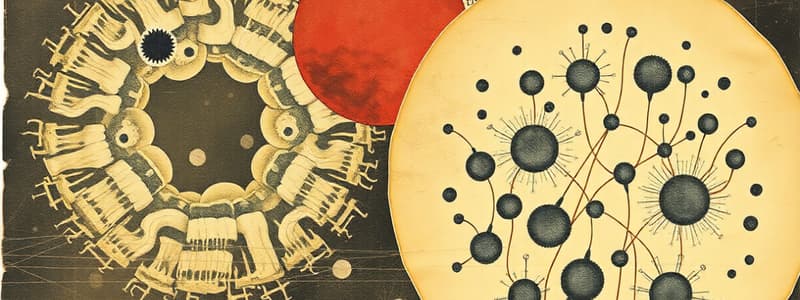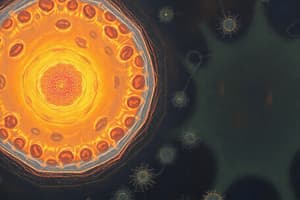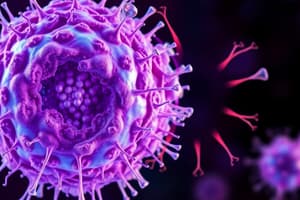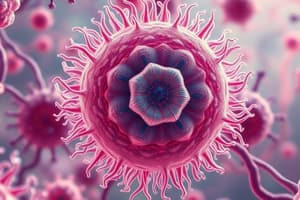Podcast
Questions and Answers
Which of these cell structures is responsible for energy production through ATP synthesis?
Which of these cell structures is responsible for energy production through ATP synthesis?
- Ribosomes
- Golgi apparatus
- Mitochondria (correct)
- Vacuoles
What is the primary function of the cell membrane?
What is the primary function of the cell membrane?
- Storing genetic material
- Regulating the passage of substances (correct)
- Breaking down waste materials
- Synthesizing proteins
Which process involves the movement of molecules from an area of high concentration to an area of low concentration, without requiring energy?
Which process involves the movement of molecules from an area of high concentration to an area of low concentration, without requiring energy?
- Diffusion (correct)
- Facilitated diffusion
- Osmosis
- Active transport
Where in the cell does glycolysis, the first step of cellular respiration, take place?
Where in the cell does glycolysis, the first step of cellular respiration, take place?
Which of these structures is found exclusively in plant cells and plays a role in photosynthesis?
Which of these structures is found exclusively in plant cells and plays a role in photosynthesis?
What is the role of the Golgi apparatus in the cell?
What is the role of the Golgi apparatus in the cell?
Which type of cell transport requires the use of energy (ATP)?
Which type of cell transport requires the use of energy (ATP)?
During photosynthesis, what is the primary source of energy used to produce glucose?
During photosynthesis, what is the primary source of energy used to produce glucose?
What is the main difference between aerobic and anaerobic respiration?
What is the main difference between aerobic and anaerobic respiration?
Which of these cell structures is involved in intracellular digestion, breaking down waste materials and cellular debris?
Which of these cell structures is involved in intracellular digestion, breaking down waste materials and cellular debris?
Which of the following is NOT a characteristic of the Calvin cycle?
Which of the following is NOT a characteristic of the Calvin cycle?
During transcription, what is the role of RNA polymerase?
During transcription, what is the role of RNA polymerase?
Which of these relationships is an example of mutualism?
Which of these relationships is an example of mutualism?
What is the primary driving force behind natural selection?
What is the primary driving force behind natural selection?
Which taxonomic category is the broadest?
Which taxonomic category is the broadest?
What is the function of the circulatory system in humans?
What is the function of the circulatory system in humans?
Which of these is NOT a mechanism of evolution?
Which of these is NOT a mechanism of evolution?
What is the role of the nervous system in maintaining homeostasis?
What is the role of the nervous system in maintaining homeostasis?
Which of these is NOT a requirement for natural selection to occur?
Which of these is NOT a requirement for natural selection to occur?
Which of these is NOT a characteristic of a healthy ecosystem?
Which of these is NOT a characteristic of a healthy ecosystem?
Flashcards
Cell
Cell
Basic unit of life with complex internal organization.
Prokaryotic Cells
Prokaryotic Cells
Cells without a nucleus or membrane-bound organelles.
Eukaryotic Cells
Eukaryotic Cells
Cells that have a nucleus and membrane-bound organelles.
Nucleus
Nucleus
Signup and view all the flashcards
Mitochondria
Mitochondria
Signup and view all the flashcards
Chloroplasts
Chloroplasts
Signup and view all the flashcards
Diffusion
Diffusion
Signup and view all the flashcards
Osmosis
Osmosis
Signup and view all the flashcards
Cellular Respiration
Cellular Respiration
Signup and view all the flashcards
Photosynthesis
Photosynthesis
Signup and view all the flashcards
Light-dependent reactions
Light-dependent reactions
Signup and view all the flashcards
Calvin Cycle
Calvin Cycle
Signup and view all the flashcards
Gene
Gene
Signup and view all the flashcards
Mutation
Mutation
Signup and view all the flashcards
Ecology
Ecology
Signup and view all the flashcards
Biodiversity
Biodiversity
Signup and view all the flashcards
Natural selection
Natural selection
Signup and view all the flashcards
Homeostasis
Homeostasis
Signup and view all the flashcards
Linnaean classification
Linnaean classification
Signup and view all the flashcards
Study Notes
Cell Structure and Function
- Cells are the basic units of life, exhibiting a complex internal organization.
- Prokaryotic cells lack a nucleus and membrane-bound organelles, while eukaryotic cells possess both.
- The cell membrane regulates the passage of substances in and out of the cell.
- The nucleus contains the cell's genetic material (DNA) and controls cellular activities.
- Mitochondria are the powerhouses of the cell, responsible for energy production through cellular respiration.
- Chloroplasts are found in plant cells and are responsible for photosynthesis.
- Ribosomes synthesize proteins according to genetic instructions.
- Endoplasmic reticulum (ER) is involved in protein and lipid synthesis.
- The Golgi apparatus modifies, sorts, and packages proteins and lipids for secretion or use within the cell.
- Vacuoles store water, nutrients, and waste products.
- Lysosomes contain enzymes that break down waste materials and cellular debris.
- Cytoskeleton provides support and shape to the cell, facilitates movement of organelles, and is involved in cell division.
Cell Transport
- Passive transport moves molecules across the membrane without energy input.
- Diffusion is the movement of molecules from high to low concentration.
- Osmosis is the diffusion of water across a selectively permeable membrane.
- Facilitated diffusion uses transport proteins to aid in the movement of molecules across the membrane.
- Active transport moves molecules against their concentration gradient, requiring energy (ATP).
- Pumps move molecules across the membrane using energy.
- Endocytosis takes in large molecules or particles by engulfing them in vesicles.
- Exocytosis releases large molecules out of the cell.
Cellular Respiration
- Cellular respiration is the process by which cells break down glucose to produce energy in the form of ATP.
- Glycolysis, the first step, occurs in the cytoplasm and breaks down glucose into pyruvic acid.
- The Krebs cycle, occurring in the mitochondria, completes the breakdown of pyruvic acid.
- The electron transport chain, also in the mitochondria, produces a large amount of ATP through oxidative phosphorylation.
- Aerobic respiration requires oxygen, while anaerobic respiration (fermentation) does not.
Photosynthesis
- Photosynthesis is the process by which plants and some other organisms use sunlight to synthesize foods from carbon dioxide and water.
- It occurs in chloroplasts, specifically in the thylakoid membranes.
- Photosynthesis involves two main stages:
- The light-dependent reactions, which convert light energy into chemical energy in the form of ATP and NADPH.
- The light-independent reactions (Calvin cycle), which use the ATP and NADPH to synthesize glucose from carbon dioxide.
Genetics
- Genes are segments of DNA that carry instructions for building proteins.
- DNA is the genetic material, a double helix structure.
- RNA is a single-stranded molecule that carries genetic information from DNA to ribosomes for protein synthesis.
- The process of protein synthesis involves transcription and translation.
- Mutations are changes in DNA sequence that can affect protein structure and function.
- Chromosomes are organized structures of DNA and proteins.
Ecology
- Ecology is the study of the interactions between organisms and their environment.
- Ecosystems consist of biotic and abiotic factors.
- Organisms interact with each other through various relationships such as predation, competition, and symbiosis.
- Populations change over time due to various factors like birth rate, death rate, and migration.
- Biodiversity is the variety of life in an ecosystem.
Evolution
- Evolution is the process by which populations of organisms change over time.
- Natural selection is a mechanism of evolution in which organisms with advantageous traits are more likely to survive and reproduce.
- Adaptations are traits that enhance an organism's survival and reproduction in a particular environment.
- Common descent explains the relatedness of all living organisms.
Classification
- Classification is the process of grouping organisms based on shared characteristics.
- The Linnaean system uses hierarchical categories (domain, kingdom, phylum, class, order, family, genus, species) to classify organisms.
- Evolutionary relationships are reflected in classification systems.
Human Biology
- Human biology encompasses the structure, function, and development of the human body.
- Key systems include the circulatory, respiratory, digestive, nervous, and endocrine systems.
- Homeostasis is the maintenance of a stable internal environment.
- The immune system protects the body from disease.
- Reproduction involves the processes of fertilization and development.
Studying That Suits You
Use AI to generate personalized quizzes and flashcards to suit your learning preferences.




